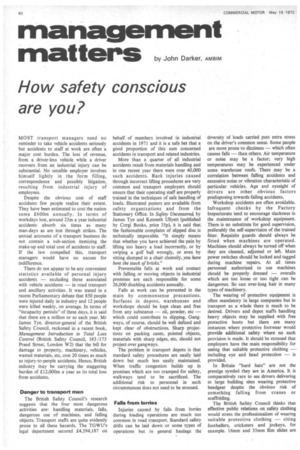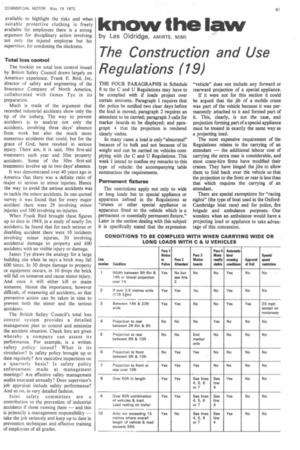management
Page 82

Page 83

If you've noticed an error in this article please click here to report it so we can fix it.
matters by John Darker, AMBIM
How safety conscious are you?
MOST transport managers need no reminder to take vehicle accidents seriously but accidents to staff at work are often a major cost burden. The loss of revenue, from a driver-less vehicle while a driver recovers from an industrial injury can be substantial. No sensible employer involves himself lightly in the form filling, correspondence and possibly litigation, resulting from industrial injury of employees.
Despite the obvious cost of staff accidents few people realize their extent. They have been estimated to cost the nation some £600m annually. In terms of workdays lost, around 23m a year industrial accidents absorb six times as many man-days as are lost through strikes. The annual accounts of a transport business do not contain a sub-section itemizing the make-up and total cost of accidents to staff. If the law compelled this, transport managers would have no excuse for indifference.
There do not appear to be any convenient statistics available of personal injury accidents — excluding those associated with vehicle accidents — in road transport and ancillary activities. It was stated in a recent Parliamentary debate that 850 people were injured daily in industry and 12 people were killed weekly, on average. In terms of "incapacity periods" of three days, it is said that there are a million or so each year. Mr James Tye, director-general of the British Safety Council, reckoned in a recent book, Management Introduction to Total Loss Control (British Safety Council, 13/173 Praed Street, London W2) that the bill for damage to property, machinery, vehicles, wasted materials, etc, cost 20 times as much as injury-to-people accidents. Hence, British industry may be carrying the staggering burden of £12,000m a year as its total loss from accidents.
Danger to transport men The British Safety Council's research suggests that the four most dangerous activities are: handling materials, falls, dangerous use of machines, and falling objects. Transport staffs are quite evidently prone to all these hazards. The TGWU's legal department secured £4,594,187 on behalf of members involved in industrial accidents in 1971 and it is a safe bet that a good proportion of this sum concerned accidents in transport and related industries.
More than a quarter of all industrial accidents result from materials handling and in one recent year there were over 40,000 such accidents. Back injuries caused through incorrect lifting procedures are very common and transport employers should ensure that their operating staff are properly trained in the techniques of safe handling of loads. Illustrated posters are available from
safety organizations and from the Stationery Office. In Safety Uncensored, by
James Tye and Kenneth Ullyett (published by Corgi Books, price 35p), it is said that. the fashionable complaint of slipped disc is technically impossible. "It simply means that whether you have achieved the pain by lifting too heavy a load incorrectly, or by
swiping a golf ball wrongly, or even by sitting slumped in a chair clumsily, you have bent the stack of bricks."
Preventable falls at work and contact with falling or moving objects in industrial premises are each responsible for some 26,000 disabling accidents annually.
Falls at work can be prevented in the main by commonsense precautions.
Surfaces in depots, warehouses and workshops should be kept clean and free from any substance — oil, powder, etc — which could contribute to slipping. Gang ways, of course, should be well defined and kept clear of obstructions. Sharp projec tions on packing cases, pointed objects, materials with sharp edges, etc, should not project over gangways.
The problem in transport depots is that standard safety procedures are easily laid down but much less easily maintained.
When traffic congestion builds up in premises which are too cramped for safety, walkways tend to be sacrificed. The additional risk to personnel in such circumstances does not need to be stressed.
Falls from lorries Injuries caused by falls from lorries during loading operations are much too common in road transport. Standard safety drills can be laid down or some types of operations but in general haulage the diversity of loads carried puts extra stress on the driver's common sense. Some people are more prone to dizziness — which often causes falls — than others. Air temperature or noise may be a factor; very high temperatures may be experienced under some warehouse roofs. There may be a correlation between falling accidents and excessive noise or vibration characteristic of particular vehicles. Age and eyesight of drivers are other obvious factors predisposing towards falling accidents.
Workshop accidents are often avoidable. Infrequent checks by the Factory Inspectorate tend to encourage slackness in the maintenance of workshop equipment. There is no substitute for good supervision, preferably the self-supervision of the trained fitter. Requisite guards should always be fitted when machines are operated. Machines should always be turned off when they are cleaned, adjusted or left. Main power switches should be locked and tagged during machine repairs. At all times personnel authorized to use machines should be properly dressed — overalls which are too loose or too tight can be dangerous. So can over-long hair in many types of machinery.
The wearing of protective equipment is often mandatory in large companies but in transport as a whole there is much to be desired. Drivers and depot staffs handling heavy objects may be supplied with free protective boots but there are many instances where protective footwear would provide additional safety where no such provision is made. It should be stressed that employers have the main responsibility for seeing that suitable protective clothing -including eye and head protection — is provided.
In Britain "hard hats" are not the prestige symbol they are in America. It is comparatively rare to see drivers delivering to large building sites wearing protective headgear despite the obvious risk of something falling from cranes or scaffolding.
The British Safety Council thinks that effective public relations on safety clothing would stress the professionalism of wearing suitable protective clothing -citing footballers, cricketers and jockeys, for example. 16rrun and 35mm film slides are
available to highlight the risks and when suitable protective clothing is freely available for employees there is a strong argument for disciplinary action involving not only the injured employee but his supervisor, for condoning the slackness.
Total loss control The booklet on total loss control issued by British Safety Council draws largely on American experience. Frank E. Bird, Jnr, director of safety and engineering of the Insurance Company of North America, collaborated with James Tye in its preparation.
Much is made of the argument that recorded industrial accidents show only the tip of the iceberg. The way to prevent accidents is to analyze not only the accidents, involving three days' absence from work but also the much more numerous accidents that could, but for the grace of God, have resulted in serious injury. There are, it is said, 30m first-aid treatments each year and 50m property accidents. Some of the 30m first-aid treatments involve up to two days' absence.
It was demonstrated over 40 years ago in America that there was a definite ratio of major to serious to minor injuries. Hence the way to avoid the serious accidents was to tackle the minor accidents. In one quoted survey it was found that for every major accident there were 29 involving minor injuries and 300 involving no injuries.
When Frank Bird brought these figures up to date in 1969, in a study of nearly 2m accidents, he found that for each serious or disabling accident there were 10 incidents involving minor injuries, 30 involving accidental damage to property and 600 accidents with no visible injury or damage.
James Tye draws the analogy for a large building site when he says a brick may fall 600 times. In 30 drops damage to property or equipment occurs, in 10 drops the brick will fall on someone and cause minor injury. And once it will either kill or maim someone. Hence the importance, however difficult, of measuring all accidents, so that preventive action can be taken in time to prevent both the minor and the serious accidents.
The British Safety Councils total loss control system provides a detailed management plan to control and minimize the accident situation. Check lists are given whereby a company can assess its performance. For example, is a written safety policy issued? What is its circulation? Is safety policy brought up to date regularly? Are executive inspections on a quarterly basis? Is safety policy enforcement made at management meetings? Are effective safety management audits executed annually? Does supervisor's job appraisal include safety performance? And so on, in very detailed fashion.
Joint safety committees are a contribution to the prevention of industrial accidents if those running them — and this is primarily a management responsibility — take the job seriously and keep up to date in prevention techniques and effective training of employees of all grades.




























































































































